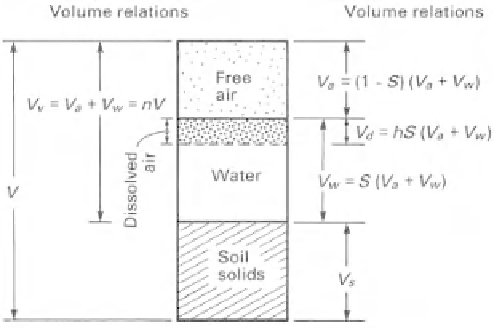Environmental Engineering Reference
In-Depth Information
The above equation gives the volume change of air with
respect to an infinitesimal change in air pressure. Substitut-
ing Boyle's law (i.e., Eq. 15.3) into Eq. 15.4 gives
15.3.2 Compressibility of Air-Water Mixtures
The compressibility of an air-water mixture can be derived
using the direct proportioning of the air compressibility and
the water compressibility. The conservation of mass and the
compressibility definition must apply. Let us consider the
air, water, and solid volumetric relations, as shown in
Fig. 15.7. Let us assume that the degree of saturation
S
and porosity
n
of the soil are known. The total volume of
the air-water mixture is the sum of the volume of water,
V
w
, and the volume of air,
V
a
(i.e.,
V
w
+
V
a
). The volume
of the dissolved air,
V
d
,
is within the volume of water,
V
w
.
The volumetric coefficient of solubility
h
gives the
percentage of dissolved air with respect to the volume of
water. The pore-air and pore-water pressures are
u
a
and
u
w
, respectively, with
u
a
always being greater than
u
w
.The
soil is subjected to a compressive total stress
σ
.
Let us apply an infinitesimal increase in total stress,
dσ
,to
the soil while maintaining undrained conditions. The pore-
air and pore-water pressures increase while the volumes of
air and water decrease. The compressibility of an air-water
mixture for an infinitesimal increase in total stress can be
written using the total stress as a reference:
dV
a
d u
a
=−
V
a
u
a
(15.5)
The volume derivative with respect to absolute pressure
(
dV
a
/d u
a
)
is equal to the derivative with respect to the
gauge pressure
(
dV
a
/
du
a
)
since the atmospheric pressure
u
atm
is assumed to be constant. Equation 15.5 can be sub-
stituted into Eq. 15.2 to give the isothermal compressibility
of air,
1
u
a
C
a
=
(15.6)
The isothermal compressibility of air is inversely propor-
tional to absolute air pressure. In other words, air compress-
ibility decreases as the air pressure increases.
15.3.1.2 Water Compressibility
The compressibility of water is defined as follows:
1
V
w
dV
w
du
w
d(V
w
−
V
d
)
dσ
C
w
=−
(15.7)
1
V
w
+
V
a
d(V
a
+
V
d
)
dσ
C
aw
=−
+
(15.8)
where:
where:
C
w
=
water compressibility,
V
w
=
volume of water,
C
aw
=
compressibility of air-water mixture,
dV
w
/
du
w
=
water volume change with respect to water
pressure change, and
V
w
+
V
a
=
volume of the air-water mixture,
V
w
=
volume of water,
u
w
=
water pressure.
V
a
=
volume of free air,
d(V
w
−
V
d
)/dσ
=
water volume change with respect to
a total stress change,
Figure 15.6 presents the results of water compressibil-
ity measurements (Dorsey, 1940). It should be noted that
dissolving air in water does not significantly change the
compressibility of water.
d(V
a
+
V
d
)/dσ
=
air volume change with respect to a
total stress change, and
V
d
=
volume of dissolved air.
,
Figure 15.6
Isothermal compressibility of air-saturated water
(from Dorsey, 1940).
Figure 15.7
Volumetric composition of pore fluid in unsaturated
soil taking dissolved air into consideration.














Search WWH ::

Custom Search